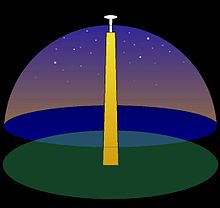Sampo

The Sampo is a device "with a colored lid" from the Finnish epic Kalevala , which creates wealth for its owner through its magical powers. In the German translation by Hans Fromm it is occasionally described as "magic mill".
The Sampo was created by the blacksmith Ilmarinen , but jealously guarded in the icy northern kingdom of Pohjola by its ruler, the magical Louhi , until it is snatched from her by the heroes of Kalevala. In the struggle for it, it breaks and spreads fertility over land and sea.
Etymology and Interpretation
Anton Schiefner , the founder of Uralic , sees in the Sampo, a mill, whose name he with Russian samo , Finnish same , Swedish samme (German "self") into communication. For a mill that grinds by itself, he finds analogies in Russian fairy tales.
For Wilhelm Johann Albert von Tettau , this mill symbolizes agriculture and the prosperity associated with it. From the Sampo "comes the sprouting of the seed, / the beginning of the changeless welfare, / plowing from it, from it sowing, / from this growth in every way." But if the Sampo not only grinds grain, but also salt and “money” (as Schiefner's translation from Finnish: raha ; it would be better after von Tettau: “medium of exchange)”, this is an indication that the seeds are the salt that is important to them could only be obtained by bartering from Germany or Russia: The Sampo grinds one day for food, the next for swap, and the third for stock.
Hans Fromm sees a possible origin of the song in the fascination with the rotary mill, which has also been widespread in Scandinavia since the third century AD . The idea of the "mill of happiness", which decisively increases agricultural productivity , probably originally came from the Mediterranean region and perhaps migrated to Karelia via Byzantium and Russia. The robbery and destruction of the Sampo would then be seen as a simile for the breaking up of a technical monopoly and the dissemination of the new technology or, more generally, as a symbol of the enculturation process . The “north country” of Pohjola should not be interpreted geographically, but as an extra-human counter-world.
Finnish authors such as Eemil Nestor Setälä , Uno Harva and Martti Haavio interpret the sampo as the support of the celestial vault or as its cultic representation: the celestial axis , marked by the pole star , or the world tree , around which the starry sky rotates, becomes cultic (possibly represented by an iron column). Their robbery or destruction is a motive in various mythologies, both in settled peasant and nomadic cultures. B. in the old Norse Freyr myth or in the report of the destruction of the Irminsul . With the Sami world trees were erected up to modern times, over which the invisible canopy of heaven spans; the pole rammed vertically into the ground is an important orientation tool for all nomadic peoples.
Both circular movements - both that of the starry sky and that of the flour mill - are symbols of incessant (self) movement, renewal and fertility.
Namesake
Sampo is the namesake of a Finnish match brand , one of the largest Finnish banking and insurance companies and a manufacturer of agricultural technology . Furthermore, an icebreaker and an asteroid are named after Sampo.
In addition, Sampo is used as a male given name in Finland.
- Movie
- 1959: The stolen happiness (original title: Sampo ), Soviet Union / Finland, director: Aleksandr Ptushko
literature
- Kalevala. The Finnish epic by Elias Lönnroth. Transl .: Lore and Hans Fromm, epilogue and Comment: Hans Fromm. Reclam 1985. In it: 10th song: Schmiedung des Sampo, 42./43. Singing: robbery, defense and destruction of the Sampo.
- Uno Harva: Sammon ryöstö. Suomen tiedettä 3. Werner Söderström OY, Porvoo 1943.
- Martti Haavio: Sammon arvoitus. Suomalainen Suomi, 1957.
Individual evidence
- ^ Wilhelm von Tettau: About the epic poems of the Finnish peoples, especially the Kalewala. Erfurt: Villaret 1873, p. 144 f.
- ↑ Kalevala XLIII, quoted from von Tettau, p. 144.
- ↑ Kalevala X and XXXVIII.
- ↑ Hans Fromm, Commentary on Kalevala, p. 426 ff.
- ↑ EN Setälä: Sammon arvoitus. Helsinki 1932.
- ↑ U. Harva: Sammon ryöstö. In: Suomen tiedettä 3rd WSOY, Porvoo Helsinki 1943.
- ↑ M. Haavio Suomalainen mytologia. WSOY, Porvoo Helsinki 1967.
- ^ Gérard de Champeaux, Sébastien Sterckx: Le monde des symboles. Zodiac, 3rd edition 1980, p. 18 ff.
